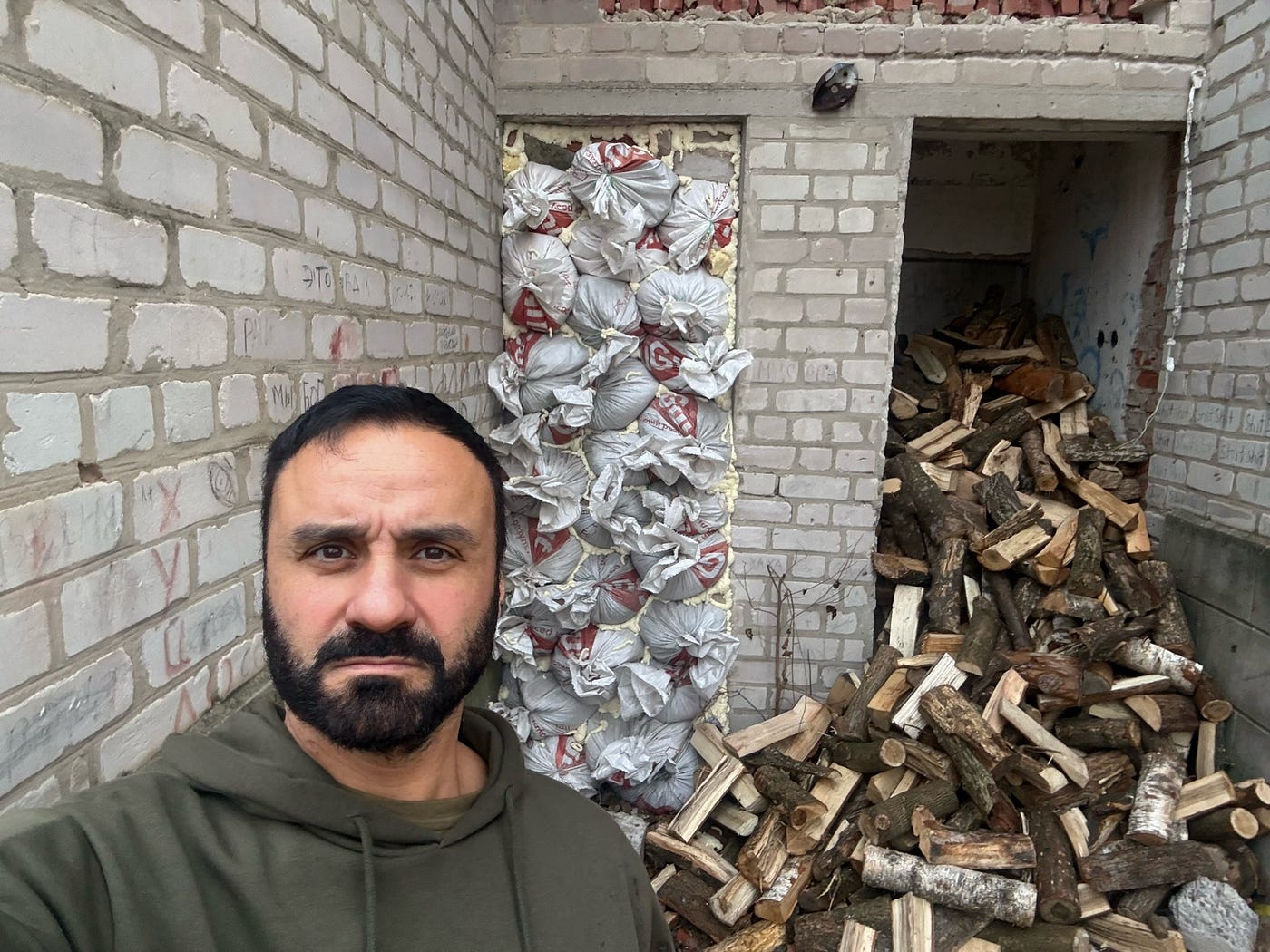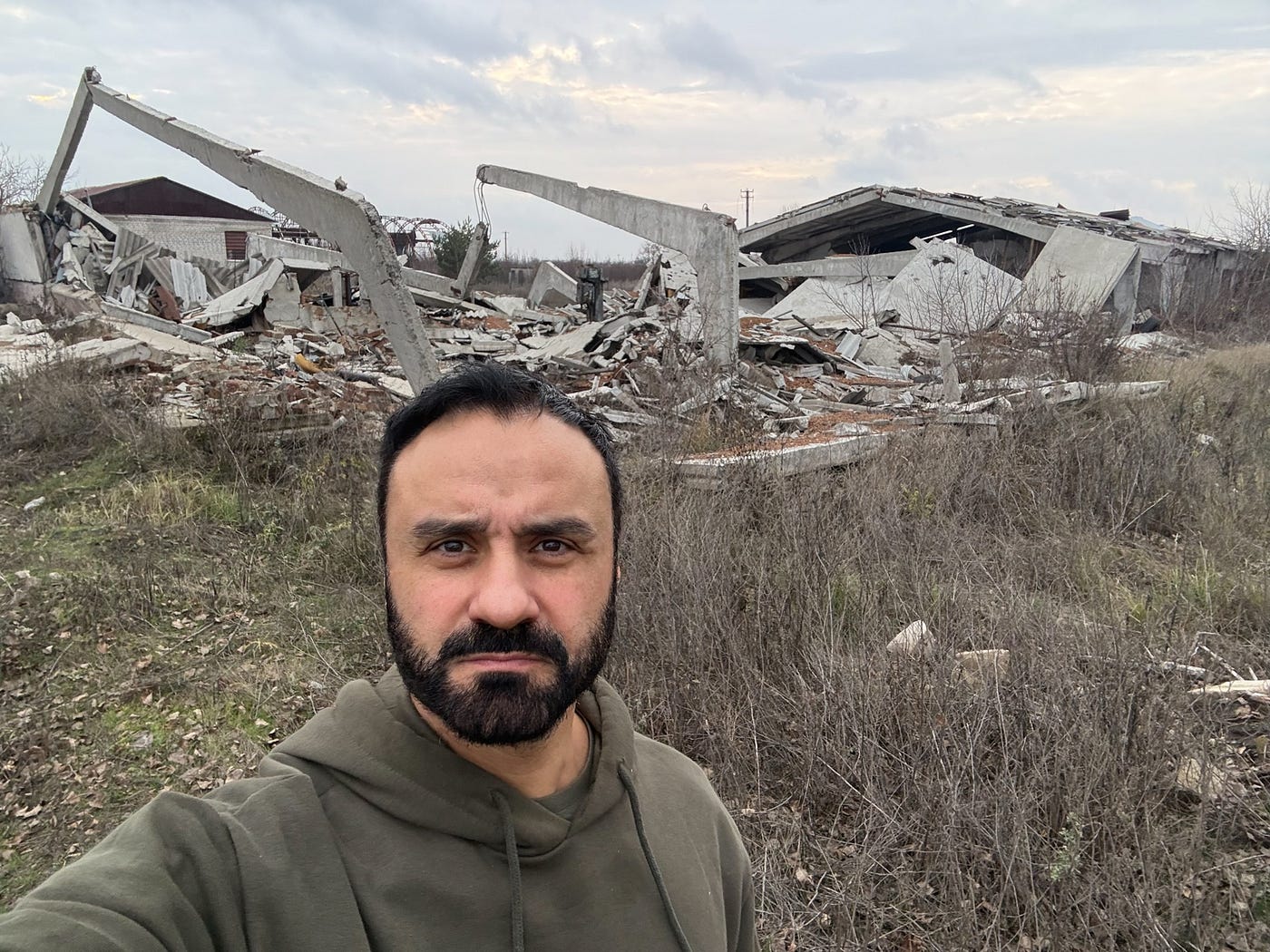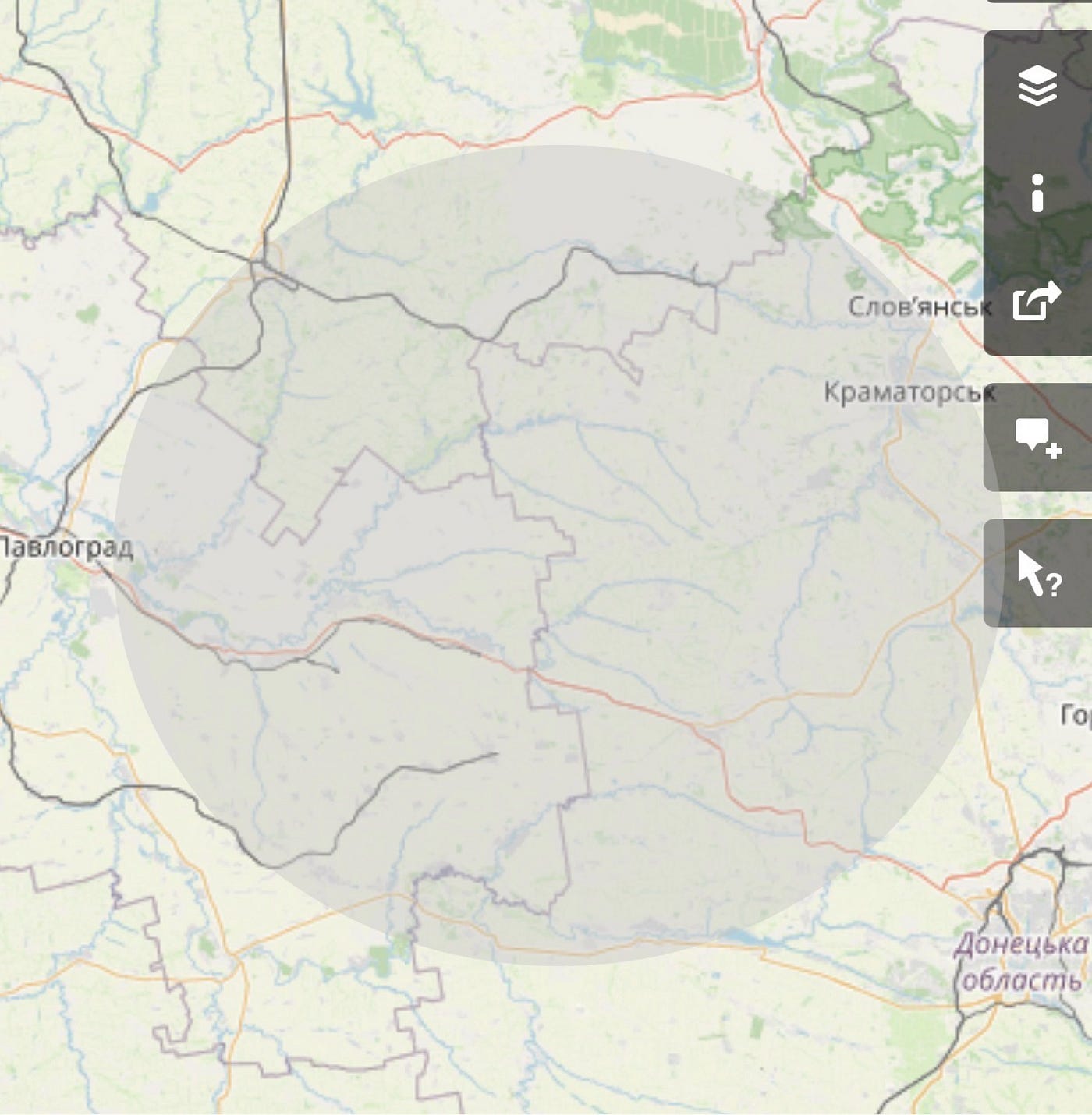Russian Troops Are Not Advancing On The Ground. Technology Is.
By: Giorgio Provinciali
Nightmare Days and Nights in Kramatorsk
Live from Ukraine
Kramatorsk – Russian (i.e., Chinese) FPV drones now reach the city center and some parts of its western outskirts, making the civilian population seldom leave their homes. Essential activities are carried out by weaving close to the walls, constantly glancing skyward before rushing back into homes or shops. Storefronts and windows are boarded up with wooden planks and plywood, and dozens of ‘РЕБ’ anti-drone antennas can be spotted on the roofs of many cars – now even civilian ones. Although our press cars have been similarly equipped, today those jamming systems are no longer enough to defend against the lethal FPV drones. Russian terror, in fact, travels along thin fiber optic cables that many Chinese companies, without any shame, openly display on their marketplaces alongside the mortar rounds those kamikaze drones carry, clearly stating their purpose.
Intentionally targeted in this way, two Ukrainian journalists died last month at a gas station not far from where I am writing. A media worker accompanying them lost a leg, and two other Dutch reporters were saved at the last second by the good aim of a soldier accompanying them while recording a documentary inside a church destroyed by the Russian Federation in Druzhkivka. Attentive readers will recall that it was from those very locations in Donbas – just south of Kramatorsk – that I wrote the article preceding this one, reporting a desperate situation.

This is happening because, although Russian troops are not advancing on the ground, technology is. This makes areas far from the front uninhabitable, areas that would not have been so at risk with the conventional weapons with which this war began.
Over the past nearly four years, the evolution of these threats – now mainly electronically guided – has enabled the Russians and Ukrainians to intervene militarily, extensively and with extreme precision, in areas up to 50 kilometers from the front. This selective targeting accuracy, monitored until the last second by the operator of an FPV drone, leaves room to extend that range of terror for a fully autonomous system managed by the new UMPK modules that convert the old FAB glide bombs into deadly KABs. The Russians can now project up to three tons of explosives to areas as far as 200 kilometers from the launch point, whereas until recently, the operational range of those glide bombs was only 50.
It’s clear how devastated areas like those I recently reported on are. Druzhkivka, located 15 km south and 18 km east of the two main Russian salients, and Kramatorsk, about 20 km from the eastern one, bear the brunt. During each sleepless night in these places, I counted an explosion roughly every three minutes, coming from artillery, FPV drones, and glide bombs.

On the other hand, Ukrainians use ground drones that the Russians don’t have, which helps limit human casualties on the front lines. Traveling with soldiers from different brigades, I saw many of them in action, admiring their engineering skill both in person and through their cameras. Taking advantage of their lead over the enemy in this area, the defenders of Pokrovsk pushed the Russian forces back beyond the railway lines, effectively clearing them out house by house. Other drones provided valuable information from above, allowing those robots to complete their missions.
Those scenes are clearly visible from Ukrainian positions through the digital eyes of ground and air drones, just as I was able to witness live the rescue of a Ukrainian soldier by a robot that reached him, loaded him inside, and then protected him throughout the journey to the armored vehicle where he was then transferred for evacuation to the nearest field hospital.
The Ukrainians lack the volume of conventional firepower available to the Russians, but not their ingenuity or technological capabilities. Of the millions of North Korean bullets disbursed by the Pyongyang regime to Moscow, only a tiny fraction was supplied by the West to Ukraine.
Moving behind the lines, I saw shells being fired from XXXXXXX toward Pokrovsk. These shells traveled nearly 100 km, showing the potential is there, but the volume is insufficient. Due to its high mobility, Ukraine has lost less than 10% of its Caesar howitzers. It has Archer self-propelled artillery guns ready to fire, launching 21 rounds in three minutes, but it is short on ammunition.

Thanks to the use of indigenously developed glide bombs, the Ukrainian Armed Forces have succeeded in cutting off one of the main Russian supply routes behind Pokrovsk. Likewise, thanks to internal solutions, they have managed to completely isolate the occupiers in Kupiansk, leaving them with no choice but to surrender or face death. Although Russian propagandists claim otherwise, the reality on the ground remains clear.
Technological evolution has made even the maps used to depict ground conditions outdated, so much so that creating useful maps requires much broader color scales to show the intensity and speed of movement.
Now it’s up to Ukraine’s partners to be equally swift, so that their ingenuity and sacrifice aren’t wasted.
THANKS TO ALL WHO HELP US BUYING DRONE DETECTORS
感謝所有幫助我們購買無人機探測器的人!
幫我們購買無人機探測器
在過去的三年裏,作為自由撰稿人,我們一直在烏克蘭戰爭的所有前線進行報導,自從大規模…
https://www.paypal.com/pools/c/9k3lwAl8Wo
俄羅斯部隊並未在地麵推進,技術才是關鍵
作者: Giorgio Provinciali
克拉馬托爾斯克的噩夢日夜
烏克蘭前線報道
克拉馬托爾斯克(Kramatorsk)——目前,俄羅斯(即中國)製造的FPV無人機已深及市中心及部分西部郊區,使得平民鮮少離開家門。人們在靠近牆壁的地方小心翼翼的進行必要的活動,時刻抬頭警惕望天,然後迅速返回家中或商店。街麵店鋪及窗戶被木板和夾板封堵,許多汽車車頂都裝有“РЕБ”反無人機天線——甚至是民用車輛。雖然我們的新聞車也裝備了類似的幹擾設備,但如今這些係統已不足以抵禦致命的FPV無人機。事實上,俄羅斯的恐怖活動依賴細小的光纖線,而許多中國公司毫不羞恥地在市場上公開展示這些光纖,旁邊還放著這些神風無人機攜帶的迫擊炮彈,彰顯它們的用途。
上個月,因被(無人機)針對性襲擊,兩名烏克蘭記者在距離我寫作地點不遠的加油站遇難。一名陪同他們的媒體工作者失去了一條腿,另外兩名荷蘭記者在德魯日基夫卡一座被俄方摧毀的教堂內錄製紀錄片時,險些遇難,幸得一名隨行士兵精準射擊,才在最後一刻得以幸免。細心的讀者或許還記得,我之前在克拉馬托爾斯克南部的頓巴斯那些地區,就曾撰寫過上一篇報道,描述那裏非常危急的形勢。
(圖:我在頓巴斯的克拉馬托爾斯克郊外——版權所有,Giorgio Provinciali)
這是因為,雖然俄軍沒有在地麵上推進,但科技正在進步。這使得遠離前線的地區變得無法居住,而如果使用這張戰爭開始時使用的傳統武器,這些地方並不會如此危險。
在過去近四年中,隨著威脅手段的演變——如今主要由電子導航控製——使得俄烏雙方得以在距離前線最多50公裏的範圍內,進行大規模且極為精準的軍事幹預。由FPV無人機操作員實時監控的這種選擇性精確打擊,為由新型的UMPK模塊控製的全自動係統擴展恐怖活動範圍提供了可能,這些模塊將舊式FAB滑翔炸彈轉變成致命的KAB炸彈。俄羅斯現在可以向離發射點200公裏遠的區域投射多達三噸的炸藥,而此前這些滑翔炸彈的投射範圍僅為50公裏。
很明顯,像我最近報道的那些地區是多麽的破壞殆盡。距離俄方兩大突出點南部15公裏,東部18公裏的德魯日基夫卡,和距東麵突出點約20公裏的克拉馬托爾斯克,遭受衝擊最為嚴重。這些地方的每一個無眠之夜,我計算過,大約每三分鍾就會有一次來自炮火、FPV無人機和滑翔炸彈襲擊的爆炸。
(圖:俄羅斯“KAB”滑翔炸彈對烏克蘭頓巴斯地區平民基礎設施的破壞——版權所有,Giorgio Provinciali)
另一方麵,烏克蘭使用俄軍所沒有的地麵無人機,有助於減少前線的人員傷亡。隨著不同旅的士兵一同出行,我見證了他們的多次作戰行動,既親眼所見,也通過攝像頭感受到他們的工程技術。利用在這一地區對敵人的優勢,波克羅夫斯克的防禦方將俄軍逼退到鐵路線以外,實質上逐屋清剿敵人。其他無人機從空中提供了寶貴的情報,使這些機器人得以順利完成任務。
從烏克蘭陣地,通過地麵和空中無人機的數字“眼睛”,可以清楚看到這些場景,就像我親眼目睹一名烏克蘭士兵被一台機器人救援的全過程:它駛到士兵身邊,將他裝載其中,保護他直到被轉移到裝甲車上,隨後送到附近的野戰醫院進行救治。
烏克蘭人在傳統火力方麵不及俄軍,但他們並不缺乏創造力和技術能力。平壤政權向莫斯科供應的數百萬發子彈中,而西方向烏克蘭提供的隻是其的極少一部分。
我在防線後方看到,XXXXX正向波克羅夫斯克發射炮彈。這些炮彈射程接近100公裏,顯示出潛力已足,但數量還遠遠不夠。由於擁有高度機動性,烏克蘭目前損失的“凱撒”榴彈炮不到10%。烏克蘭還部署了“弓箭”自行火炮,能夠在三分鍾內發射21發炮彈,但彈藥庫存不足。
(圖:我決定發布一份較少細節的地圖版本,旨在防止敵人獲取寶貴信息——原地圖由OpenStreetMap提供)
得益於自主研發的滑翔炸彈,烏克蘭武裝部隊成功切斷了波克羅斯克後方的一條主要俄軍補給線。同樣,憑借內部技術方案,他們已設法完全隔離了庫皮揚斯克的占領軍,迫使其別無選擇,隻能投降或麵對死亡。盡管俄方宣傳者聲稱情況並非如此,但地麵形勢依然清晰明了。
科技的不斷發展使得用於展現地麵狀況的地圖也變得過時,繪製有效的地圖已需要更廣泛的色標,以反映移動的強度和速度。
現在,烏克蘭的盟友們也需要同樣迅速行動,才能確保他們的智慧和犧牲不被白白浪費。